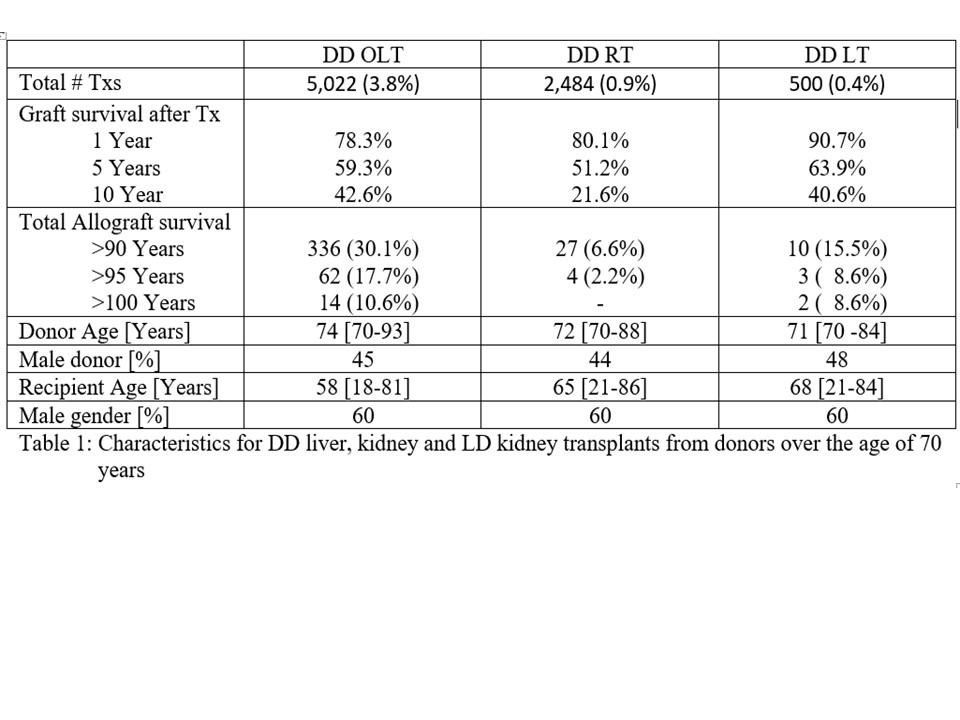The Centennial Allograft – Can an Organ Function for Over 100 Years in 2 Different Individuals?
SUNY Downstate Medical Center, Brooklyn, NY
Meeting: 2020 American Transplant Congress
Abstract number: B-175
Keywords: Donation, Kidney transplantation, Liver transplantation, Outcome
Session Information
Session Name: Poster Session B: Liver: Recipient Selection
Session Type: Poster Session
Date: Saturday, May 30, 2020
Session Time: 3:15pm-4:00pm
 Presentation Time: 3:30pm-4:00pm
Presentation Time: 3:30pm-4:00pm
Location: Virtual
*Purpose: We investigated the occurrence of deceased-donor liver (DDOLT), deceased-donor renal (DDRT), and living-donor renal allografts (LDRT) that have achieved or come close to 100 years of physiologic function in 2 different individuals.
*Methods: All adult single-organ transplants from donors over 70 years of age, DDOLT (n=5,022), DDRT (n=2,484), and LDRT (n=500) reported to UNOS/OPTN from 10/87 to 03/19 were evaluated. LDOLT were not considered due to the relative novelity of this procedure. Allograft survival was calculated according to the equation: Allograft Survival = Allograft Age at Donation + Allograft Survival; it was categorized as age of 90-94 years, 95-99 years, or 100 years and longer. Graft survival was defined as function time to date, most recent follow-up or death, re-listing for transplant, or (for kidney transplants) initiation of renal replacement therapy. Multivariate analysis assessed predictors of physiologic allograft survival in liver and kidney transplants.
*Results: Table 1 shows the characteristics and outcomes. Outcome of DDOLT increased over time in general and 336 grafts showed physiological function > 90 years; in 14 cases the duration of function was > 100 years. The longest function time is 105.3 years and counting. Likewise, DDRT and LDRT allograft survival improved throughout the study period: 27 DDRT and 10 LDRT were still functioning at 90 years. In contrast to DDOLT, only 2 LDRT graft reached the 100 year mark. Multivariate analysis of each cohort verified that good donor and recipient management factors are potential predictors of allograft longevity.
*Conclusions: Organ longevity in 2 different individuals exceeding 100 physiologic years is possible. It represents a small but increasing minority of grafts in transplant recipients. It is expected that more grafts will reach this mark with increasing follow-up time. The observation of extended longevity is higher among liver vs. kidney allograft recipients. Increases in allograft longevity between DDRT and LDRT are similar over time but more common in DDRT.
To cite this abstract in AMA style:
Gruessner A, Renz J, Saggi S, Gruessner R. The Centennial Allograft – Can an Organ Function for Over 100 Years in 2 Different Individuals? [abstract]. Am J Transplant. 2020; 20 (suppl 3). https://atcmeetingabstracts.com/abstract/the-centennial-allograft-can-an-organ-function-for-over-100-years-in-2-different-individuals/. Accessed December 20, 2025.« Back to 2020 American Transplant Congress

